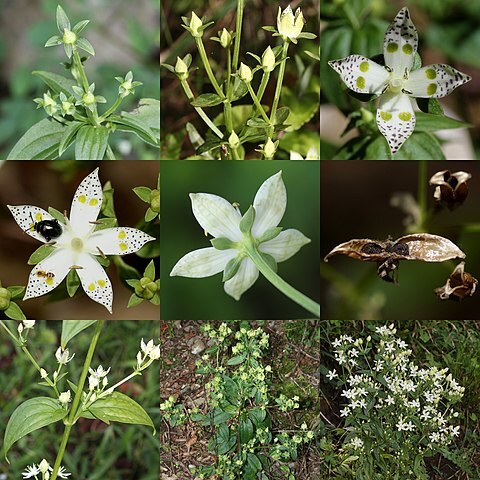Annuals 30-140(-200) cm tall. Roots yellow, fibrous. Stems erect, 2-6 mm in diam., branched. Basal leaves withered at anthesis. Stem leaves sessile or short petiolate; leaf blade broadly elliptic to ovate-lanceolate, 3.5-9 × 1-4(-5) cm, base narrowly tapered to obtuse, apex acuminate; veins 3-5, arcuate. Inflorescences panicles of cymes, lax, spreading branched, many flowered, to 50 cm. Flowers 5merous. Pedicel spreading to erect, 0.6-4 cm, stout, terete. Calyx tube 1-2 mm; lobes narrowly oblanceolate to narrowly elliptic, 3-6 mm, base narrowed, margin slightly revolute and membranous, apex acuminate; veins 3-5, indistinct. Corolla yellow or white, with purple spots, to 2.5 cm in diam., tube 1-2 mm; lobes oblong to elliptic, 1-1.5 cm, base narrowed, apex acuminate to acute. Nectaries 2 per corolla lobe, yellow-green, orbicular, reduced to a naked gland patch without raised margin. Filaments 5-6.5 mm; anthers ellipsoid, ca. 2.5 mm. Style indistinct; stigma lobes capitate. Capsules narrowly ovoid, to 2.3 cm. Seeds brown, globose; seed coat warty. Fl. and fr. Jun-Nov.
More
A herb. It grows each year from seed. It grows 30-140 cm tall. The roots are yellow and fibrous. The stems are 2-6 mm across. The leaves on the stem do not have stalks. The leaves are oval and 4-9 vm long by 1-4 cm wide. They taper to the base. The flowers are in loose branched heads. They are yellow or white with purple spots. The fruit is a narrow oval capsule 2.3 cm long.
Wet grassy places in lowland and mountains. Beside streams, swamp, meadows, scrub, evergreen forests and shady forest floors; at elevations from 200-3,700 metres.
More
It is a warm temperate to tropical plant. It grows beside streams and in forests between 200-3,000 m above sea level in China. In Sichuan and Yunnan.

